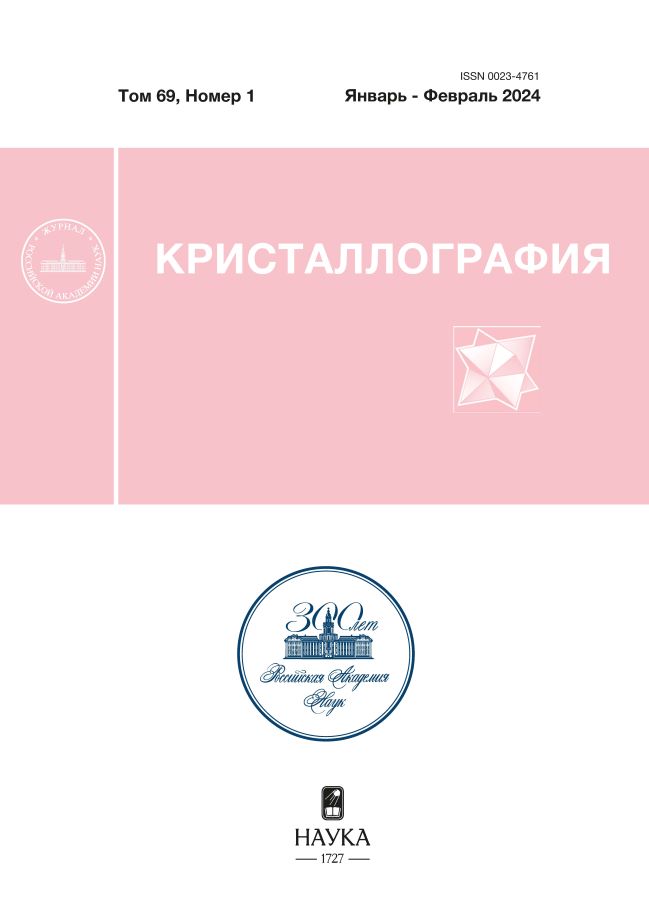Структура доменных и антифазных границ в κ-фазе оксида галлия
- Авторлар: Вывенко О.Ф.1, Бондаренко А.С.1, Убыйвовк Е.В.1, Шапенков С.В.1,2, Печников А.И.2, Николаев В.И.2, Степанов С.И.2
-
Мекемелер:
- Санкт-Петербургский государственный университет
- Физико-технический институт им. А.Ф. Иоффе
- Шығарылым: Том 69, № 1 (2024)
- Беттер: 34-39
- Бөлім: REAL STRUCTURE OF CRYSTALS
- URL: https://rjdentistry.com/0023-4761/article/view/673223
- DOI: https://doi.org/10.31857/S0023476124010057
- EDN: https://elibrary.ru/tainbq
- ID: 673223
Дәйексөз келтіру
Аннотация
Представлены результаты экспериментального исследования реальной структуры тонких пленок κ-фазы оксида галлия. Методами дифракции обратно отраженных электронов в сканирующем электронном микроскопе и просвечивающей электронной микроскопии установлено, что микро-монокристаллы κ-оксида галлия состоят из совокупности трех типов поворотных доменов орторомбической симметрии, повернутых друг относительно друга на угол 120° вокруг оси роста. Монокристаллические домены характеризуются большой плотностью прямолинейных антифазных границ, формирующих при своем пересечении структуру значительной доли доменных границ.
Толық мәтін
Авторлар туралы
О. Вывенко
Санкт-Петербургский государственный университет
Хат алмасуға жауапты Автор.
Email: oleg.vyvenko@spbu.ru
Ресей, г. Санкт-Петербург
А. Бондаренко
Санкт-Петербургский государственный университет
Email: oleg.vyvenko@spbu.ru
Ресей, г. Санкт-Петербург
Е. Убыйвовк
Санкт-Петербургский государственный университет
Email: oleg.vyvenko@spbu.ru
Ресей, г. Санкт-Петербург
С. Шапенков
Санкт-Петербургский государственный университет; Физико-технический институт им. А.Ф. Иоффе
Email: oleg.vyvenko@spbu.ru
Ресей, г. Санкт-Петербург; г. Санкт-Петербург
А. Печников
Физико-технический институт им. А.Ф. Иоффе
Email: oleg.vyvenko@spbu.ru
Ресей, г. Санкт-Петербург
В. Николаев
Физико-технический институт им. А.Ф. Иоффе
Email: oleg.vyvenko@spbu.ru
Ресей, г. Санкт-Петербург
С. Степанов
Физико-технический институт им. А.Ф. Иоффе
Email: oleg.vyvenko@spbu.ru
Ресей, г. Санкт-Петербург
Әдебиет тізімі
- Nikolaev V.I., Stepanov S.I., Romanov A.E., Bougrov V.E. Single Crystals of Electronic Materials. Elsevier, 2019. 487 p.
- Pearton S.J., Yang J., Cary P.H. et al. // Appl. Phys. Rev. 2018. V. 5. P. 011301. https://doi.org/10.1063/1.5006941
- Stepanov S.I., Nikolaev V.I., Bougrov V.E. et al. // Rev. Adv. Mater. 2016. V. 44. P. 63.
- Playford H.Y., Hannon A.C., Barney E.R. et al. // Chem. Eur. J. 2013. V. 19. P. 2803. https://doi.org/10.1002/chem.201203359
- Chang K.-W., Wu J.-J. // Appl. Phys. A. 2003. V. 76. P. 629. https://doi.org/10.1007/s00339-002-2016-1
- Yao Y., Okur S., Lyle L.A.M. et al. // Mater. Res. Lett. 2018. V. 6 P. 268. https://doi.org/10.1080/21663831.2018.1443978
- Ahmadi E., Oshima Y. // J. Appl. Phys. 2019. V. 126 P. 160901. https://doi.org/10.1063/1.5123213
- Cuscó R., Domènech-Amador N., Hatakeyama T. et al. // J. Appl. Phys. 2015. V. 117. P. 185706. https://doi.org/10.1063/1.4921060
- Boschi F., Bosi M., Berzina T. et al. // J. Cryst. Growth. 2016. V. 443. P. 25. https://doi.org/10.1016/j.jcrysgro.2016.03.013
- Xia X., Chen Y., Feng Q. et al. // Appl. Phys. Lett. 2016. V. 108 P. 202103. https://doi.org/10.1063/1.4950867
- Chen X., Xu Y., Zhou D. et al. // ACS Appl. Mater. Interfaces. 2017. V. 9. P. 36997. https://doi.org/10.1021/acsami.7b09812
- Pavesi M., Fabbri F., Boschi F. et al. // Mater. Chem. Phys. 2018. V. 205. P. 502. https://doi.org/10.1016/j.matchemphys.2017.11.023
- Chen X., Ren F., Gu S., Ye J. // Photonics Res. 2019. V. 7. P. 381. https://doi.org/10.1364/PRJ.7.000381
- Hou X., Zou Y., Ding M. et al. // J. Phys. D. 2021. V. 54. P. 043001. https://doi.org/10.1088/1361-6463/abbb45
- Oshima Y., Kawara K., Shinohe T. et al. // APL Mater. 2019. V. 7. P. 022503. https://doi.org/10.1063/1.5051058
- Nikolaev V.I., Stepanov S.I., Pechnikov A.I. et al. // ECS J. Solid State Sci. Technol. 2020. V. 9. P. 045014. https://doi.org/10.1149/2162-8777/ab8b4c
- Shapenkov S., Vyvenko O., Ubyivovk E. et al. // Phys. Status Solidi A. 2020. V. 217. P. 1900892. https://doi.org/10.1002/pssa.201900892
- Oshima Y., Víllora E.G., Matsushita Y. et al. // J. Appl. Phys. 2015. V. 118 P. 085301. https://doi.org/10.1063/1.4929417
- Степанов С.И., Печников А.И., Щеглов М.П. и др. // Письма в ЖТФ. 2022. Т. 48. С. 35. https://doi.org/10.21883/PJTF.2022.19.53594.19169
- Yakimov E.B., Polyakov A.Y., Nikolaev V.I. et al. // Nanomater. 2023. V. 13 P. 1214. https://doi.org/10.3390/nano13071214
- Polyakov A.Y., Nikolaev V.I., Pechnikov A.I. et al. // APL Mater. 2022. V. 10. P. 061102. https://doi.org/10.1063/5.0091653
- Cora I., Mezzadri F., Boschi F. et al. // CrystEngComm. 2017. V. 19. P. 1509. https://doi.org/10.1039/C7CE00123A
- Fornari R., Pavesi M., Montedoro V. et al. // Acta Mater. 2017. V. 140. P. 411. https://doi.org/10.1016/j.actamat.2017.08.062
- Zhuo Y., Chen Z., Tu W. et al. // Appl. Surf. Sci. 2017. V. 420. P. 802. https://doi.org/10.1016/j.apsusc.2017.05.241
- Cora I., Fogarassy Zs., Fornari R. et al. // Acta Mater. 2020. V. 183. P. 216. https://doi.org/10.1016/j.actamat.2019.11.019
- Oshima Y., Kawara K., Oshima T., Shinohe T. // Jpn. J. Appl. Phys. 2020. V. 59. P. 115501. https://doi.org/10.35848/1347-4065/abbc57
- Shapenkov S., Vyvenko O., Nikolaev V. et al. // Phys. Status Solidi. B. 2021. V. 259. P. 2100331. https://doi.org/10.1002/pssb.202100331
- Kneiß M., Splith D., Schlupp P. et al. // J. Appl. Phys. 2021. V. 130. P. 084502. https://doi.org/10.1063/5.0056630
Қосымша файлдар














